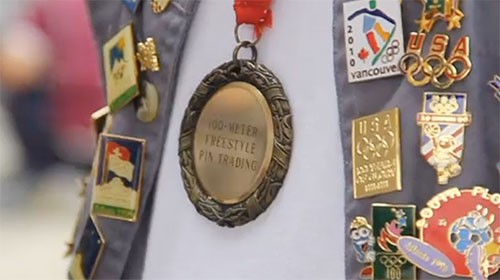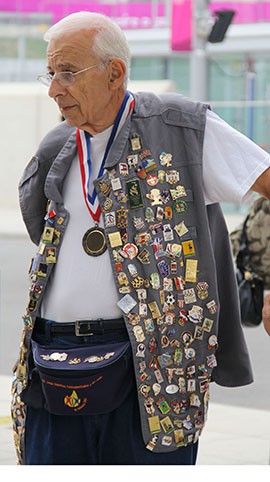Cronkite News has moved to a new home at cronkitenews.azpbs.org. Use this site to search archives from 2011 to May 2015. You can search the new site for current stories.
Gold medals aren’t the only things up for grabs at Olympics
LONDON – Even before the Summer Games kicked off Olympic Park buzzed with competition. But these participants weren’t seeking gold, silver or bronze.
Just outside of the Olympic Village, dozens of spectators from around the world participate in their sport of choice: pin trading.
Leonard Braun, a retiree from Los Angeles who has been involved in the ritual since 1984, has his own way of attracting fellow traders at the games.
“I had a gold medal made up,” Braun said. “A lot of the athletes come over because they think it might be real, and a lot of them laugh.”
But Leonard said pin trading is nothing to scoff at.
“I tell them, ‘Don’t laugh, my sport is, I’m sure, as hard as yours,’” he said.
Braun said pin trading can be fiercely competitive and unpredictable. Pins that were popular and difficult to find at the last games may be easy to come by at the next. He has spent years building a collection of every pin he can find.
His collection is so extensive, in fact, that he doesn’t know how many pins he owns.
“I haven’t counted since I got to 20,000, so it’s something over that,” Braun said.
Don’t ask him to pick a favorite. “Impossible,’’ he said.
Having traded pins with famous athletes and royalty from all around the world, Braun is arguably among one of the most decorated pin traders. He said he has traded with everyone from Queen Sofia of Spain at the 2004 Summer Games in Athens and Prince Albert of Monaco at the 2006 Winter Games in Torino, Italy.
While Braun has traded Olympic pins almost 30 years, the tradition dates back to the 1896 Olympics in Athens, when pins were colored cardboard discs that identified athletes, judges and officials.
Trading became popular among the athletes, and by the 1904 Summer Games in St. Louis the pins, now made of metal, became increasingly ornate. At the 1912 Summer Olympics in Stockholm, the first commercially produced pins became available to spectators and the hobby took off. Now enthusiasts bring assortments of pins to trade for pins their collections lack.
The community of pin traders outside Olympic Park is close-knit; many traders have known one another for decades.
Daniel Presburger, a teacher from Los Angeles, wants to make sure his twin children, Rosemary and Ailan, 12, become part of that community.
Like Braun, Presburger has nearly 30 years of experience trading pins. He started collecting at the 1984 Summer Games in Los Angeles and has attended 12 Olympics. He began taking his children to the games in Beijing in 2008.
“I like them to have the experience of meeting people from other countries, other places and (seeing) other ways of doing things,” Presburger said.
Braun also recognizes the “amazing” opportunity trading pins presents, as people from all around the world come together in one place to share pieces of their cultures.
“That is only going to happen at the Olympics, no place else,” Braun said.










